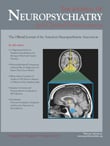Possible Rabbit Syndrome With Amisulpride
To the Editor: Recently, rabbit syndrome has been reported with newer antipsychotic drugs such as clozapine, risperidone, olanzapine, and aripiprazole. 1 We report the case of an elderly man with depressive disorder who developed rabbit syndrome as an acute extrapyramidal side effect after addition of amisulpride to ongoing mianserin therapy. To our knowledge, this is the first case report in the existing literature of rabbit syndrome associated with amisulpride.
Case Report
Mr. A, a 78-year-old man, presented with a history of depression, diurnal variation of mood, nihilistic delusion, and disturbed biological functions of 4 months’ duration. His brother had bipolar disorder; however, there was no family history of movement disorder. Mr. A’s hypertension was well stabilized with amlodipine, 5 mg/day, for the last 5 years. The diagnosis of major depression with psychotic features was established according to DSM-IV criteria. All his routine investigations were within normal limits except lipid profile. Initially, he was treated with mianserin, 15 mg/day, and olanzapine, 2.5 mg/day, but olanzapine was stopped due to drowsiness and the dose of mianserin was gradually increased to 30 mg per day. Since there was no improvement in his depressive and psychotic symptoms even after taking this medicine for 4 weeks, 50 mg of amisulpride was added and subsequently increased to 150 mg/day over a period of 10 days. In addition, he was also taking alprazolam, 0.5 mg/day, and lorazepam, 1 mg/day. On the fifth day of amisulpride therapy, an abrupt onset of abnormal perioral movements was noticed. These were rapid, fine, and rhythmic involuntary movements of lip and jaw on a vertical axis. Detailed examination also revealed mild parkinsonian symptoms in the form of rigidity, bradykinesia, tremor, and salivation but no dystonic reaction. Estimation of abnormal movements by abnormal involuntary movement scale provided a score of 9. An MRI scan of his head and an EEG were within normal limits. A diagnosis of rabbit syndrome was made, and amisulpride was replaced by trihexyphenidyl, 4 mg/day. On the sixth day of trihexyphenidyl therapy, all perioral movements as well as parkinsonian symptoms subsided. Trihexyphenidyl was gradually withdrawn over the next 2 weeks. A further 2 weeks later, the patient did not report for his scheduled appointment and was subsequently lost to follow-up.
Discussion
As noticed in our case, a large majority of cases with rabbit syndrome also have other signs of drug-induced parkinsonism. 2 One can argue that mianserin might have been a contributory factor in the emergence of rabbit syndrome as there was a single report of oral dyskinesia and torticollis associated with mianserin. 3 It is also possible that mianserin might have potentiated the motor side effects of amisulpride by increasing the amisulpride level. However, our case did not developed rabbit syndrome while he was on mianserin as a monotherapy. Further, amisulpride is substituted benzamides with high affinity and selectivity for the dopamine D2 and D3 receptors mainly responsible for dyskinesia, 4 whereas mianserin has no or little effect on the dopaminergic system. 3 Clinicians who prescribe amisulpride ought to be aware of this adverse effect.
1. Catena Dell’osso M, Fagiolini A, Ducci F, et al: Newer antipsychotics and the rabbit syndrome. Clin Pract Epidemol Ment Health 2007; 3:6Google Scholar
2. Casey DE: Rabbit syndrome, in Movement Disorders in Neurology and Psychiatry. Edited by Joseph B, Young RR. London, Blackwell Science, 1999, pp 119–122Google Scholar
3. Otani K, Kaneko S, Fukushima Y, et al: Involuntary movements associated with mianserin treatment: a case report. Br J Psychiatry 1989; 154:113–114Google Scholar
4. Moller HJ: Amisulpride: limbic specificity and the mechanism of antipsychotic atypically. Prog Neuropsychopharmacol Biol Psychiatry 2003; 27:1101–1111Google Scholar
5. Jeste DV, Doongaji DR, Linnolia M: Elevated cerebrospinal fluid noradrenaline in tardive dyskinesia. Br J Psychiatry 1984; 144:177–180Google Scholar



